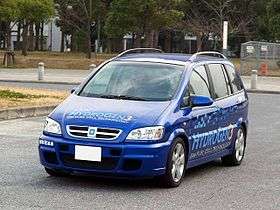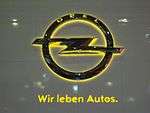GM HydroGen3
| HydroGen3 | |
|---|---|
 | |
| Overview | |
| Manufacturer | Opel (General Motors) |
| Production | 2001-2006 |
| Body and chassis | |
| Class | Compact MPV |
| Body style | 5-door MPV |
| Related | Opel Zafira |
| Powertrain | |
| Engine | Fuel-cell with 94 kW |
| Dimensions | |
| Wheelbase | 2,694 mm (106 in) |
| Length | 4,350 mm (171 in) |
| Width | 1,750 mm (69 in) |
| Height | 1,685 mm (66 in) |
| Chronology | |
| Predecessor | HydroGen1 |
| Successor | GM HydroGen4 |
HydroGen3 is an Opel hydrogen fuel cell vehicle used for testing.[1] HydroGen3’s 400-kilometer (250 mi) driving range is the highest of any fuel cell vehicle approved for public roads in Japan. The five seater front-wheel driven prototype is based on the Opel Zafira compact MPV.
Technical specifications

HydroGen3 during the FC Expo 2007 in Japan
- Fuel storage system: there are two hydrogen storage system used:
- liquid hydrogen: stainless steel liquefied hydrogen tank, installed ahead of rear axle under rear seat, length/diameter 1000/400 mm, capacity 68l/4.6 kg, gross weight 90 kg (198 lb).
- compressed hydrogen at 700 bar.
- Fuel cell unit: 200 individual fuel cells wired in series, voltage 125-200 V, dimensions: 472×251×496 mm, active area: 800 cm2, pressure: 1.5-2.7 bars, output: 94 kW, power density: 1.6 kW/l or 0.94 kW/kg.
- electric traction system: Three-phase asynchronous electric motor with integrated power electronics and planetary gear, operating voltage: 250-380 V, output: 60 kW, torque: 215 Nm, max. engine rpm: 12000, gear ratio: 8.67:1, gross weight: 92 kg (203 lb), dimensions: 4317×1742×1684 mm, vehicle curb weight: 1590 kg (target value), performance: acceleration 0–100 km/h: 16 s, top speed: 160 km/h (99 mph), operating range: 400 km.
See also
References
- ↑ "Fuel Cell Vehicles:Status 2007". March 20, 2007. doi:10.1016/j.jpowsour.2006.12.073.
This article is issued from Wikipedia - version of the 7/22/2016. The text is available under the Creative Commons Attribution/Share Alike but additional terms may apply for the media files.
